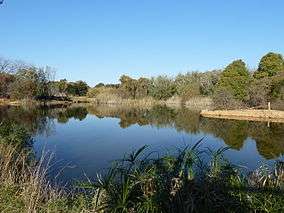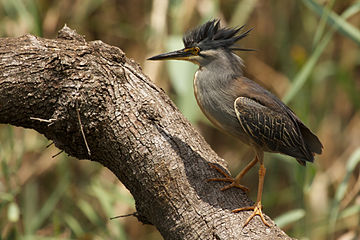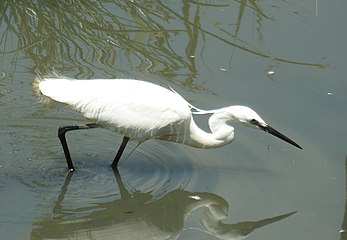Austin Roberts Bird Sanctuary
The Austin Roberts (Memorial) Bird Sanctuary is a 11.76 ha (29.1 acres) nature reserve located in the Walkerspruit Open Space System, in the Nieuw Muckleneuk suburb of Pretoria, South Africa. It became the first bird refuge in Pretoria when it was opened by the then mayor of Pretoria, Mr. W. J. Seymore, on 27 October 1956.[1][2] It was officially proclaimed as a nature reserve on 26 February 1958, and it was fenced in June 1970.[3]
| Austin Roberts Bird Sanctuary | |
|---|---|
 View of the main dam | |
| Location | Pretoria, South Africa |
| Coordinates | 25°46′13″S 28°13′40″E |
| Area | 11.76 ha (29.1 acres) |
| Established | 1956 |
The sanctuary is named after South Africa's well-known ornithologist and mammalogist, J. Austin Roberts. He was born in Pretoria in 1883, but grew up in Potchefstroom as a minister's son, where the local amateur ornithologist, Thomas Ayres, was his mentor.
Access
Free access is limited to the bird hide, which is reached from the northern perimeter, where a small exhibition facility is located. It has been declared a provincial heritage site due to its recreational and educational value.
Habitat
A former clay quarry at the confluence of Walker and Argo Spruit was allowed to fill with water, and some exotic trees were planted along its verges. In addition nine small perennial dams or wetland basins have been created, some with artificial islands, to accommodate aquatic birds and animals. The natural veld type of the sanctuary is mixed bushveld.
Bird species
Upwards of 170 native bird species have been recorded, but the presence or breeding of some have been transient, due to urbanization and other factors.[4] Resident or visiting passerine birds include thick-billed weaver, southern red bishop, African reed-warbler, little rush-warbler and lesser swamp-warbler.[2] Various heron species visit the reserve, including black-crowned night-heron,[2] little bittern, green-backed heron, purple heron, black and little egret. Other regular water birds are red-knobbed coot, fulvous duck, Egyptian goose, white-faced duck, Cape teal and southern pochard.[4] Pinioned crowned cranes and blue cranes have been released into the reserve, and some exotic duck species are present.
Gallery
 Striated herons are regular visitors to the sanctuary
Striated herons are regular visitors to the sanctuary Blacksmith lapwing on the dam shore
Blacksmith lapwing on the dam shore A little egret near the bird hide
A little egret near the bird hide
References
- "Homage to South Africa's pioneer ornithologist". Conservation heritage route information board. Pretoria Metro. Retrieved 28 November 2013.
- "Austin Roberts Bird Sanctuary (Brooklyn)". southafricaexplorer.co.za. Retrieved 28 November 2013.
- "Austin Roberts Memorial Bird Sanctuary". Nature Conservation. City of Tshwane. Archived from the original on 3 December 2013. Retrieved 28 November 2013.
- "Austin Roberts Bird Sanctuary Pretoria". Gauteng tourist attractions. sa-venues.com. Retrieved 1 December 2013.
![]()